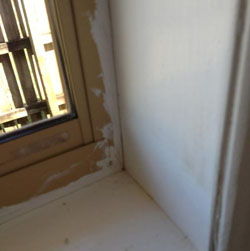Fixing Bad Paint Jobs
You wouldn’t believe how many bad paint jobs we see when we’re out and about in people’s homes.
At a rough guesstimate I’d say we are asked to quote on fixing dodgy paint jobs at least once a week. Some of this work has been done by the homeowner who was trying to save money and do it themselves. But most of it has been done by cut rate “painters” who do things quickly and with little care or skill – or qualifications.
Common Signs of a Bad Paint Job
- They don’t prepare the surfaces properly
- They don’t use the right paint types in the right areas
- They don’t provide high quality finishes.
So how much does it cost to fix a bad paint job? In the long run it costs the home owner a lot of time and money getting the dodgy work fixed, and more stress – which no-one needs!
We thought we’d share with you some examples of bad paint jobs we’ve been called in to fix up.
Bad cutting in
What is “cutting in”? Cutting-in is the practice of manually drawing straight lines of paint alongside elements that do not get painted – like windows. It can be done by using masking tape to protect the window frame, or if you are a skilled professional painter with a steady hand, you draw the line freestyle, without tape.



This is a job we were asked to fix. It was heart breaking to see so much paint on these aluminium windows and took quite a bit of effort to remove it.
The Kraudelt Painting team has had many years practice to master the art of cutting in. It’s not something you pick up after a few days! It involves using the right brushes, having the right amount of paint on the brush, perfecting the stroke and having a steady hand and eye. Leave this task to our expert house painters.

Craig Kraudelt cuts in with a steady hand

Perfect cutting in achieves crisp
lines and no paint on the
aluminium window
Spattered knobs and power points
There’s nothing screams “amateur” like painted splattered over door knobs and power points. Time and time again we see this, and we wonder why! How to fix this patchy paint job? The few minutes it takes to remove the knob or mask off the powerpoint is well worth it, because getting paint off later when it has dried is not that easy and takes longer than you think.

Sloppy work,
this is going to be hard to remove.

We always remove door handles
before painting doors.
Uneven wall finishes
There’s lots of things that can go wrong and cause walls to look awful when the paint dries. Here’s just a few things to look out for and what causes them.

Picture Framing

Poor Flow/Leveling

Sagging
Picture Framing
This unevenness is not due to painting around a picture frame! In fact it’s the result of the painter using a brush for the edges and a roller or spray gun for the main wall area. The spread of the paint with the brush is far less, so the paint goes on thicker. The edges were also done much earlier and dried before the middle was started.
Poor Flow / Leveling
Uneven finishes like this are usually the result of using low quality paints, and the paintwork being touched up again with a brush or roller when it’s only partially dried, so the flow is affected. We only use premium quality water-based paints, which are formulated with ingredients to enhance paint flow. Brush and roller marks thus tend to 'flow out' and form a smooth film. We also only use rollers with the recommended nap length for the type of paint or high quality brushes.
Sagging
Sagging paint – that drips down the surface like this is generally caused by too much paint, overly thinned paint, or painting in very humid weather. The only solution is to sand it back when it’s dry and start again using the recommended spread rate.
Need Help?
If you’ve got some really ordinary paint finishes in areas of your home, give us a call and we’ll pop over and check it out for you and give you a quote for redoing. You can rest assured that we will NEVER leave any area of your home with finishes like these.
